It looks like you're using an Ad Blocker.
Please white-list or disable AboveTopSecret.com in your ad-blocking tool.
Thank you.
Some features of ATS will be disabled while you continue to use an ad-blocker.
share:
a reply to: dragonridr
The majority of Japanese are descendants of Koreans or rather people who made there way to the islands via the Korean Peninsular who settled there over thousands of years, there is also some Chinese ancestry but also Ainu who are the original indigenous people of japan, the Japanese differ from westerners in one neurological matter in that they tend to process musical sound in the opposite hemisphere to that which Europeans do and this may explain why some Japanese traditional music makes use of the black key notes which we can sometimes find a little jarring.
The Ainu are the Jomon or rather there descendants and they tend to look much more western in some ways than mongoloid with large features and curly hair
factsanddetails.com...
The majority of Japanese are descendants of Koreans or rather people who made there way to the islands via the Korean Peninsular who settled there over thousands of years, there is also some Chinese ancestry but also Ainu who are the original indigenous people of japan, the Japanese differ from westerners in one neurological matter in that they tend to process musical sound in the opposite hemisphere to that which Europeans do and this may explain why some Japanese traditional music makes use of the black key notes which we can sometimes find a little jarring.
The Ainu are the Jomon or rather there descendants and they tend to look much more western in some ways than mongoloid with large features and curly hair
factsanddetails.com...
originally posted by: LABTECH767
a reply to: dragonridr
The majority of Japanese are descendants of Koreans or rather people who made there way to the islands via the Korean Peninsular who settled there over thousands of years, there is also some Chinese ancestry but also Ainu who are the original indigenous people of japan, the Japanese differ from westerners in one neurological matter in that they tend to process musical sound in the opposite hemisphere to that which Europeans do and this may explain why some Japanese traditional music makes use of the black key notes which we can sometimes find a little jarring.
The Ainu are the Jomon or rather there descendants and they tend to look much more western in some ways than mongoloid with large features and curly hair
factsanddetails.com...
I actually heard that before find it interesting since Japanese style does tend to clash when it comes to music.
a reply to: dragonridr
Dragonrider the Ta-Nahasians were and their descendants are among the Blackest folks in the world, even so you can clearly see that some were exceeding black and others the same chocolate skin tone of the Kemities, matter of fact such extreme black tones is rare among Africans. in among Western Blacks even more so.
If we go by tone skin tone among self Id, Black folks it is the chocolates that ruled supreme
in terms of numbers.
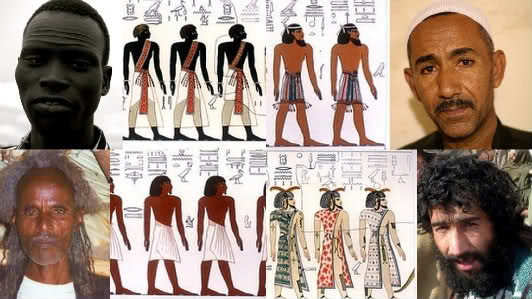
A mock-up of the people from the
Sudan the Levant Egypt and Libya.

People like this former rebel from the Sudan is rarely seen
in the west and much of Africa, but is taken as the archetype

Staying on the Nile and East Africa the type of Black
most of us are familiar in the west.
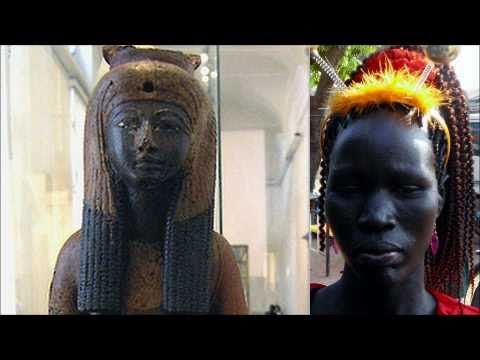

Note I haven't leave the Nile valley
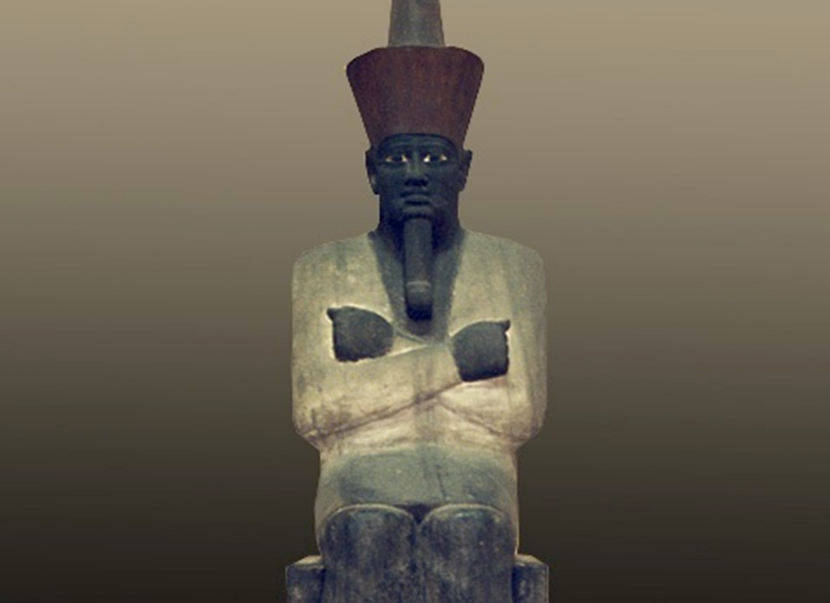
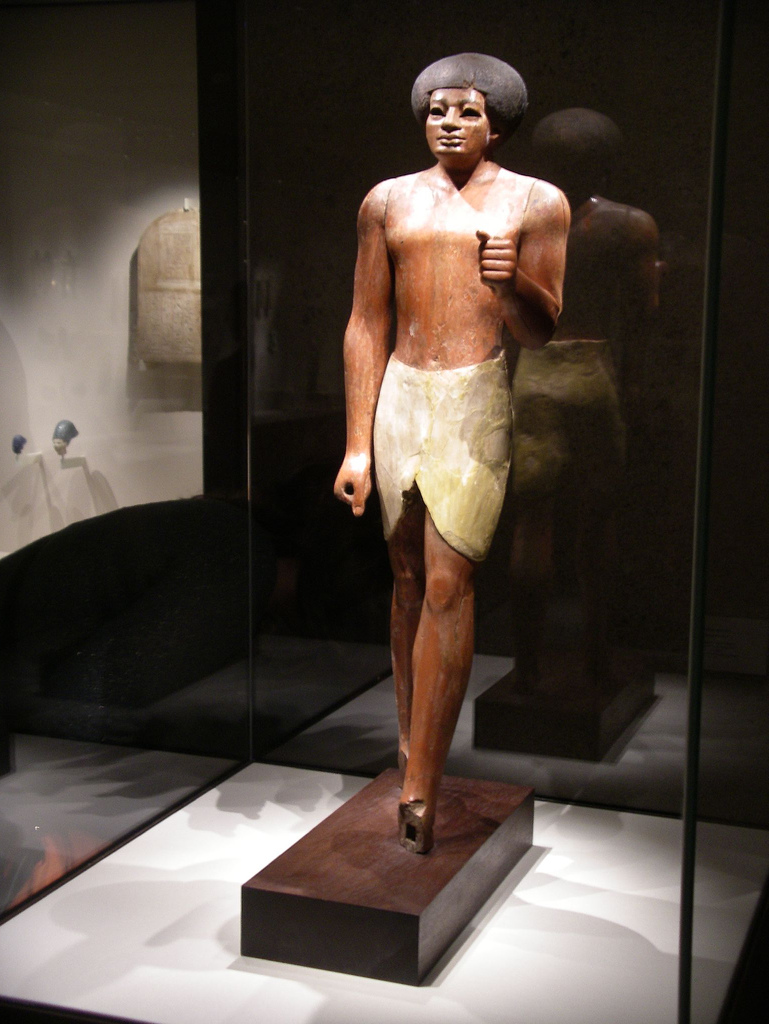

Puntites East African from the land
of the Gods and ancestors according to them.
Dragonrider the Ta-Nahasians were and their descendants are among the Blackest folks in the world, even so you can clearly see that some were exceeding black and others the same chocolate skin tone of the Kemities, matter of fact such extreme black tones is rare among Africans. in among Western Blacks even more so.
If we go by tone skin tone among self Id, Black folks it is the chocolates that ruled supreme
in terms of numbers.

A mock-up of the people from the
Sudan the Levant Egypt and Libya.

People like this former rebel from the Sudan is rarely seen
in the west and much of Africa, but is taken as the archetype

Staying on the Nile and East Africa the type of Black
most of us are familiar in the west.


Note I haven't leave the Nile valley



Puntites East African from the land
of the Gods and ancestors according to them.
a reply to: Spider879
The puntites were nubian who indeed were black in fact ruled the lower Nile. wasn't until they tried to invade the upper Nile was there even a conflict. Later upper and lower egypt become united under 1 rule. You see that on pharaohs headdress were later they take on ruler of both. Basically the a asyrian army kicks them out the Nile delta. And that's how you get a pharaohs daughter with blonde hair. Or why king Tut has obvious European and nit African lineage DNA even confirms nordic. The old kingdom but even the puntites are argued to be Indian subgroup. They were often depicted with red skin. Though I've seen evidence on both sides of this and not willing to call it.
Problem is race was not an issue at the time so all we can do is interpret text and and pictures. And DNA te sting gives mixed results. Partly because egypt was interracial. There were hitites Nubians asyrian and even Akkadians, for example the scorpion king.
PS the woman with red hair wow .
The puntites were nubian who indeed were black in fact ruled the lower Nile. wasn't until they tried to invade the upper Nile was there even a conflict. Later upper and lower egypt become united under 1 rule. You see that on pharaohs headdress were later they take on ruler of both. Basically the a asyrian army kicks them out the Nile delta. And that's how you get a pharaohs daughter with blonde hair. Or why king Tut has obvious European and nit African lineage DNA even confirms nordic. The old kingdom but even the puntites are argued to be Indian subgroup. They were often depicted with red skin. Though I've seen evidence on both sides of this and not willing to call it.
Problem is race was not an issue at the time so all we can do is interpret text and and pictures. And DNA te sting gives mixed results. Partly because egypt was interracial. There were hitites Nubians asyrian and even Akkadians, for example the scorpion king.
PS the woman with red hair wow .
edit on 4/1/15 by dragonridr because: (no reason given)
originally posted by: coomba98
Hay all I had this thread on another forum that went pretty well. Ill try to remember how the OP started.
Not sure if this should go in the Origins and Creationism area.
Also this is not a racist thread nor do I wish racist comments. Facts are not racist but if said fact are written on this thread
to be derogatory I would like the mods to remove it.
No race is better than any other. All has geniuses, dumbarses, trouble makers, saints and more.
Where did the White man come from?
Africans or Congoid came from Africa;
Asians or Mongoloid came from Asia;
Indians or Malay came from India;
American Indians came from Mesoamerica;
White man or Caucasian came from ???
As a white man I feel kind of left out with our ancient history and having no original home land.
I dont buy it that white man became white because we lived in caves. Thats BS to me.
Some human biologists say its because we have the most Neanderthal DNA in our mix than other races.
But im going off point, how we became white is not the question.
Where did the White man come from? Where is their homeland?
Coomba98
No vitamin D in cold climates, no babies for dark skinned people because of rickets, narrowing the hips. Lighter skinned people got more Vitamin D, so natural selection if you will, took its course.
a reply to: LABTECH767
The language being song in isn't Japanese.
Am friends with some Ainu folks ^^played at one of my events, if the Japanese as a distinct cultural group are cool the Ainus are waay kool chilled, have a no worries attitude, if I can say this, they are likened to first nation Americans, on the other end of the island chain are the Okinawans slightly darker than mainland Japanese but way more colorful and cheerful, their music make you wanna join in and they do insist, Japanese traditional music is very somber,introspective..but too much of it on a dark rainy day when everyone hates you , you might contemplate slitting your wrist.
Okay neither is exactly traditional in the strictist sense but you get a feel for it.
Back on script, the Ainus are hairy everyone seemed to have notched eye brows,they looked some what different but that's just from me eyeballing them,there have been alot of gene exchange from the dominant Japanese culture.
The language being song in isn't Japanese.
Am friends with some Ainu folks ^^played at one of my events, if the Japanese as a distinct cultural group are cool the Ainus are waay kool chilled, have a no worries attitude, if I can say this, they are likened to first nation Americans, on the other end of the island chain are the Okinawans slightly darker than mainland Japanese but way more colorful and cheerful, their music make you wanna join in and they do insist, Japanese traditional music is very somber,introspective..but too much of it on a dark rainy day when everyone hates you , you might contemplate slitting your wrist.
Okay neither is exactly traditional in the strictist sense but you get a feel for it.
Back on script, the Ainus are hairy everyone seemed to have notched eye brows,they looked some what different but that's just from me eyeballing them,there have been alot of gene exchange from the dominant Japanese culture.
edit on 1-4-2015 by Spider879 because: (no reason
given)
originally posted by: dragonridr
a reply to: Spider879
The puntites were nubian who indeed were black in fact ruled the lower Nile. wasn't until they tried to invade the upper Nile was there even a conflict. Later upper and lower egypt become united under 1 rule. You see that on pharaohs headdress were later they take on ruler of both. Basically the a asyrian army kicks them out the Nile delta. And that's how you get a pharaohs daughter with blonde hair. Or why king Tut has obvious European and nit African lineage DNA even confirms nordic. The old kingdom but even the puntites are argued to be Indian subgroup. They were often depicted with red skin. Though I've seen evidence on both sides of this and not willing to call it.
Problem is race was not an issue at the time so all we can do is interpret text and and pictures. And DNA te sting gives mixed results. Partly because egypt was interracial. There were hitites Nubians asyrian and even Akkadians, for example the scorpion king.
PS the woman with red hair wow .

Okay this is a common error many people make but understandable given everyone's usual orientation , Lower Egypt is north towards the Mediterranean, Upper Egypt is to the south towards Sudan and inner Africa, only a people with a southern orientation would view the world this way,they were looking back towards the direction from which they came and the Nile's natural flow.
Also we have to be careful of not lumping time,dynasties and nations together, The Ta-Nahasians were the so-called Nubians or better yet Kush-ites the Pwntites were not, nor did they ever invade Egypt under their own power, the Egyptians referred to that area as Ta-Khenset or God's land, Lands of the ancestors or beginning this was around southern Somalia Kenya Uganda area,or mountains of the moon.
The Assyrians didn't stay for they had problems with Elamites and Persians breathing down their necks,so power returned to Kmtians proper,Hittiites never made it they were put on ice many centuries earlier by Ramses himself, the Akkadians never got to Egypt never mind the movie the Scorpion king as he was an upper Kmtian from dyn zero.
Tut's supposed European trait have been dealt with see exchanges between Tadaman and my self a couple pgs back.
And yes she is of supreme hottness..
a reply to: Spider879
Egyptian texts claimed he was from akhad. This is the protodynastys. Basically a bunch of warlords fighting for upper egypt. Scorpion 2 was somewhere around Abados. And according to egyptians united the upper and lower egypt. He became dynasty 0 because they mention him in the first and second dynasties than in the 3rd he disapears.
Than around the 10th he makes a reaperance on text. And the story gets told by the priests. This is why he was chosen for the movie. Since it was claimed he was and we'll to the proto dynasties akhad ians were the ultimate warriors.
Egyptian texts claimed he was from akhad. This is the protodynastys. Basically a bunch of warlords fighting for upper egypt. Scorpion 2 was somewhere around Abados. And according to egyptians united the upper and lower egypt. He became dynasty 0 because they mention him in the first and second dynasties than in the 3rd he disapears.
Than around the 10th he makes a reaperance on text. And the story gets told by the priests. This is why he was chosen for the movie. Since it was claimed he was and we'll to the proto dynasties akhad ians were the ultimate warriors.
edit on 4/1/15 by dragonridr because: (no reason
given)
a reply to: peter vlar
You are correct IMO. As dragonridr already said, Sumerians were a breakaway group from northern tribes that were predominantly blond and redheaded originally. They may represent another group of families in those northern tribes that started to have black hair become a dominant trait and as such formed separate social groups until they just left or were expelled. Red hair came first. Red man, or ADAM, ADAPA, as the names mean, were red heads. Lilith was supposedly a redhead, or as she was later known, Lili. Eve , Aixa, whatever, was blond. I forget where that is established if either in the traditional bible or in sumerian texts.
The "black headed" people were noticeably different for their black hair. They perhaps were a mix of black peoples and nordic whites. Maybe even eastern populations from the Americas. If they were black populations they would have a name like Adapa whose name means RED MAN. Sumerians would use a name that meant "Black men", not blackheads.
There are passages in sumerian texts describing some Gods settling in the north where it is colder and pine trees grew. This supposedly before the age of man. Before Adapa.
IMO, the Americas spread into the Asia, and not the other way around.
Just a thought.
You are correct IMO. As dragonridr already said, Sumerians were a breakaway group from northern tribes that were predominantly blond and redheaded originally. They may represent another group of families in those northern tribes that started to have black hair become a dominant trait and as such formed separate social groups until they just left or were expelled. Red hair came first. Red man, or ADAM, ADAPA, as the names mean, were red heads. Lilith was supposedly a redhead, or as she was later known, Lili. Eve , Aixa, whatever, was blond. I forget where that is established if either in the traditional bible or in sumerian texts.
The "black headed" people were noticeably different for their black hair. They perhaps were a mix of black peoples and nordic whites. Maybe even eastern populations from the Americas. If they were black populations they would have a name like Adapa whose name means RED MAN. Sumerians would use a name that meant "Black men", not blackheads.
There are passages in sumerian texts describing some Gods settling in the north where it is colder and pine trees grew. This supposedly before the age of man. Before Adapa.
IMO, the Americas spread into the Asia, and not the other way around.
Just a thought.
edit on 4 1 2015 by tadaman because: (no reason given)
originally posted by: dragonridr
a reply to: Spider879
Egyptian texts claimed he was from akhad. This is the protodynastys. Basically a bunch of warlords fighting for upper egypt. Scorpion 2 was somewhere around Abados. And according to egyptians united the upper and lower egypt. He became dynasty 0 because they mention him in the first and second dynasties than in the 3rd he disapears.
I respectfully disagree, I can't remember any text that stated that, the clostest thing would be the Gebrel Arak knife
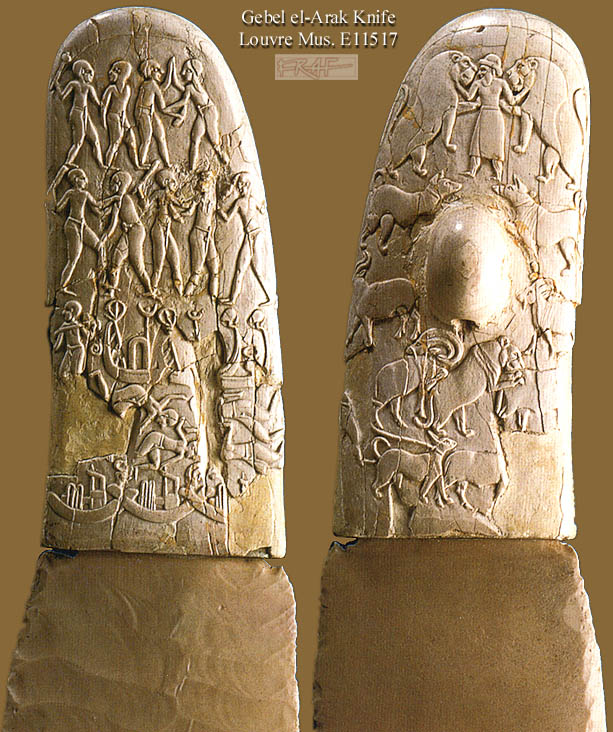
Gebrel Arak Knife an attempted invasion of Kmt.

A dyn 0 naval battle scene.
According to the above this was an invasion by non Nile valley folks of probable Mesopotamian origins but who made the Knife was the invaders or the defenders if that's what it was.
And according to Petrie Below is the black ship at Hierakonpolis, belonging to the black men who are shown as conquering the red men.
Scorpion was no where near this date and that invasion was dealt with there were no settlement of Mesopotamian on the the Nile.
Gebel el-Arak Knife
Pre-historic Egypt, Naqada II
(3500-3100 B.C.)
Petrie, W.M. Flinders. The Making of Egypt, London. New York, Sheldon Press; Macmillan, pp. 65-66, 1939. Petrie famously known as "The Father of Pre-history".
Chapter VII. The Dynastic Conquest
Conflict of Races
We now have to view as a whole the tumultuous age of dynastic invasion. For some centuries we may see large movements going on, threats from the south and east, and influences from other quarters--one of the great ages of unrest and admixture like the ages of the XIII-XVIIth or XXIIIrd-XXVth dynasties. This troubled time occupied the Semainean age.
For a demonstration of the invasion by the dynastic race, one of the greatest events in the history of Egypt, we turn to a single sculpture in ivory, the knife handle from Gebel el-Arak, probably presented to some great chief. The flint blade of the knife was a fine example of parallel flaking. The ivory handle is carved in relief on both sides. On the top of the first side is shown a combat between short-haired men with bullet heads and long-haired men. The bullet heads, like the followers of Narmer, are in all cases getting the better. Both parties are unclothed, but wear a waist cord to hold up a dagger sheath. The invaders only are armed, using a truncheon. In the lower scene are two lines of ships, and drowned men lying in the sea between them. The upper line is of vessels with high prow and stern, the lower has vessels with cabins like the Egyptian. This is Egyptian history what the Bayeux tapestry is to English history, a national monument of conquest. Happily this is not the only representation of these opposing people, but they are shown also on the one painted tomb at Hierakonpolis. There are also combats of black men overcoming red men.
Source of the Conquerors
Adding to the history, there is on the other side of the knife handle a figure of a hero or divinity subduing two lions. Such a group is widely spread, anciently, with lions in Elam, Mesoptamia and Greece; tigers in the Harappa of India; winged bulls or horses in Assyria; ibex in Arabia and deer in Italy; wolves at Athens; swans in Greece. For various animals we see that the idea is not the restraint of violence, but the assumption of power over all Nature, however untamable. Such then is the purpose of this group, and the source of it is a cold country, for the hero has a thick coat and cap, and the lions have thick hair under the whole body as a protection in snow. It must be from mountainous Elam and not from the plains of Mesopotamia that the figures come. The two beautiful figures of dogs belong to the Babylonian myth of Etana on the flying eagle, with two dogs looking up after it. Below these are exquisitely spirited figures of animals, the connection of which we cannot realize in the broken connection.
Here is an historic monument of the highest value, but badly wreaked by the Government policy of seizing discoveries. In a free system of rewards, the tomb where this lay would have comes under official care, all collateral objects would have been preserved, and every fragment of such an ivory could be recovered by sifting. But this object was never known officially till in the hands of the dealer.
The ships on the ivory knife handle are distinguished by having an animal head on the prow, probably as a figurehead. These are the bull's head and the oryx head, and they possibly signify the names of the vessels. Below is the black ship at Hierakonpolis, belonging to the black men who are shown as conquering the red men; and the other ship of these conquering invaders on the knife handle, with the similar high prow and round-topped cabin. The subjects of the invasion and conquest carved on this knife handle, and depicted with such vigour . . . . serve to clear away the distorted view of supposing all the history to have been a smooth uniform development of a single people. - W.M. Flinders Petrie
ia700407.us.archive.org...
Why would this be important??.. because this was the only early chance for a Mesopotamian invasion to take Egypt but it simply didn't happened matter of fact they stormed down the Nile all the way to the Mediterranean and set-up shop there , they took what was left of the Baderian culture of Lower Egypt and cemented it over with their own. the Kings of Ta-Seti aka Nubia would set the pace and standard for what was to become Nile valley culture for the next 3000yrs.
edit on 1-4-2015 by Spider879 because: (no reason given)
originally posted by: dragonridr
a reply to: Spider879
Cairo museum has a section on him when I was their they showed the Mesopotamian influence in the predynastic. Even the leaflets used to show royalty is from mesopatamia. So as I said even the Egyptians place him from there.
I hear you loud and clear the above put Mesopotamians on the Nile contesting the locals, and apart from the Baderian culture of Lower Kmt which does show mixed Mesopotamian influence I can find no text that made King Scorpion an Akkadian chief, plus the royal paraphernalia is Sudanese or Ta-Nahasian we would expect to find the paraphernalia to be Mesopotiamian at that time.
originally posted by: dragonridr
a reply to: Spider879
As for your post first they were asiatic as you admit but then you claim they were African your post makes no sense. Asians were white at that time toda when we think Asians what we mean is mongols and Pacific islanders. Chinese for example are part European but mostly mongol. With the exception of Japan you can see they don't really fit into the Asian mongol. I have a feeling this was Asians fleeing from the mongols found refuge in Japan.
Sorry for the late reply on this post, I never said they were African I said they were Black Asiatics, they were the ones making connection between themselves and Africans, the Greeks later followed suite, genetics and language disagree with both Greeks and the Sumerians themselves.
edit
on 1-4-2015 by Spider879 because: (no reason given)
Dragonrider,
Sumerians, although described themselves as 'the blacked headed people' they also had olive skin.
Google sumerian paintings and check out the images. all had olive skin. White people where not the predominant people of Sumeria. Trust me here im abit of a Sumerian nut case. Just like Egypt, the most predominant people were not white but black. I think the whiteness came into it in the later years of Egypt. Not the begining.
tadaman,
there is no evidence that I have found that Sumerians were blond or redheaded.
All Sumerian painting show people who have olive skin and black hair.
Its all in their ancient paintings. I think thats the best clue.
Coomba98
Sumerians, although described themselves as 'the blacked headed people' they also had olive skin.
Google sumerian paintings and check out the images. all had olive skin. White people where not the predominant people of Sumeria. Trust me here im abit of a Sumerian nut case. Just like Egypt, the most predominant people were not white but black. I think the whiteness came into it in the later years of Egypt. Not the begining.
tadaman,
there is no evidence that I have found that Sumerians were blond or redheaded.
All Sumerian painting show people who have olive skin and black hair.
Its all in their ancient paintings. I think thats the best clue.
Coomba98
a reply to: Spider879
OK, so I've spent the past couple of hours doing this a little old school and unfortunately, that means books so I've still got to cross reference some things with an internet source that I can cite for reference because I'm not going to expect you to take my word that I read this or that in support of an argument or position. Right now I'm still sifting through work from my usual go to guy for everything ancient in the fertile crescent, Samuel Noah Kramer. For reference purposes, this is what I'm working through right now-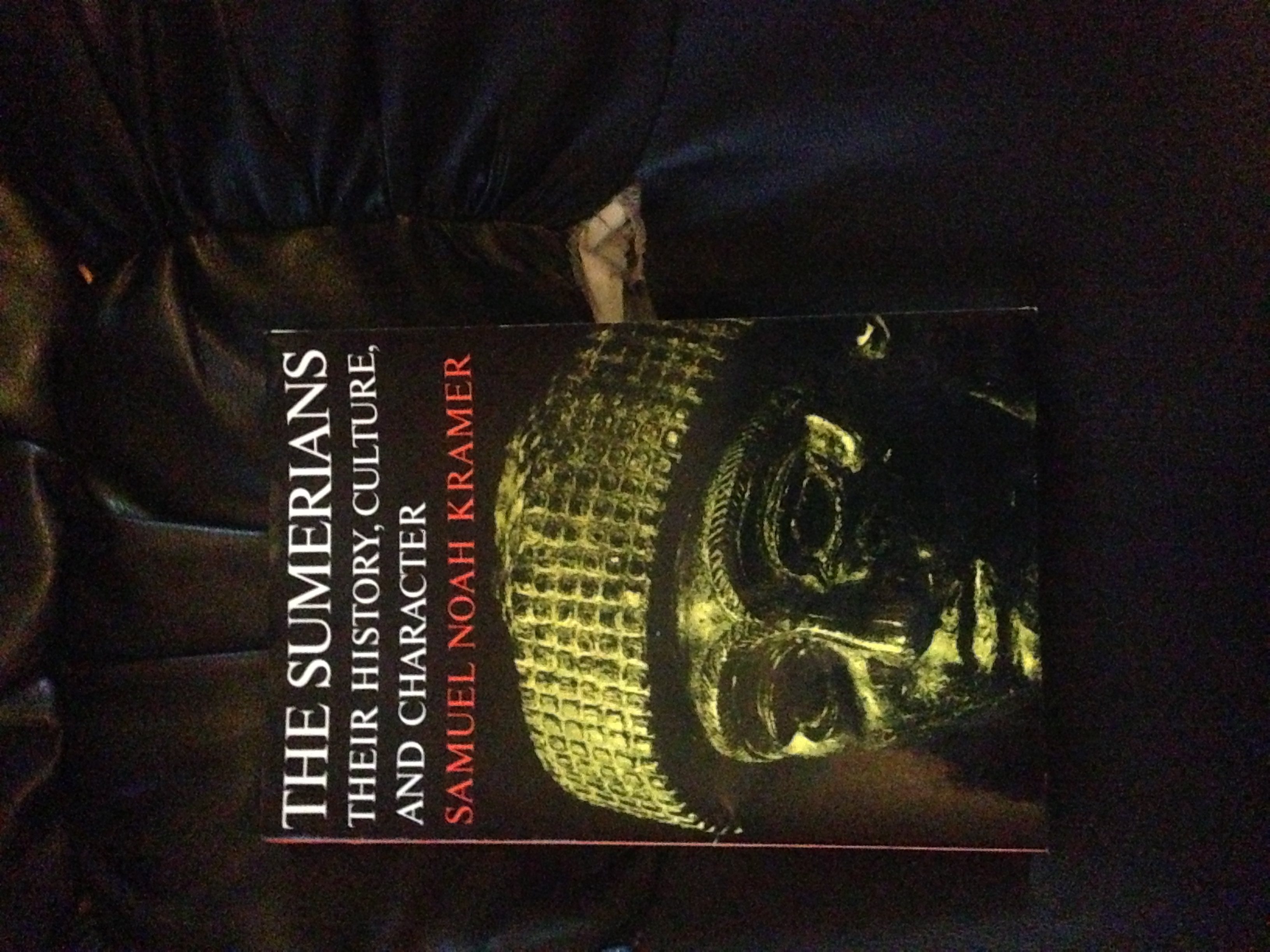
I don't like to assume but judging from your post history and how well read you seem to be on this period of history and the area in general I don't think it would be a huge stretch to assume you've at least a passing familiarity with Kramer and his reputation. Anyway... this isn't really my area so I'm trying to dot my I's and cross my T's here as I go on a crash course of re-familiarization with material I haven't given more than a few passing glances at in several years. I'd rather get it correct and admit an error than sit here and try to blow smoke up your ass to bully a point across that may not be the right point. But I digress. Kramer seems to agree with you that at least the Sumerian elite referred to themselves as 'ung sang gig-ga'(alternatively Sag-gia) or in English, The Black Headed People. So it appears I was indeed wrong that this was a reference reserved for the Akkadians. I believe still though, that this is a reference to hair color, perhaps as a status indicator as many cylinder seals from the Uruk period as well as many early dynastic votive sculptures, rarely show men with hair or beards compared with depictions of self described Ung Sang Gig-Ga being shown with both hair and beards, heavier clothes as well as weapons in hand and are typically drawn larger than average people depicting their higher status. Additionally, the hairless, beardless Sumerians of the Uruk period appear to be engaged in workforce activities whereas the Ung Sang Gig-Ga are never doing work in their depictions. I could be wrong and will continue to sift through the literature but I strongly feel that what we are seeing is a reference to hair color as opposed to skin color. And while from a later period there is specific mention of blonde haired people in the form of slaves from Gutium which is generally considered to be western/north western Iran who eventually conquered Sumeria but were referred to as Mam-ruti which has been translated as 'light haired'. Eventually, Sag-gia was used to refer to all Mesopotamians but in the early Uruk period it definitely had a different connotation originally.
OK, so I've spent the past couple of hours doing this a little old school and unfortunately, that means books so I've still got to cross reference some things with an internet source that I can cite for reference because I'm not going to expect you to take my word that I read this or that in support of an argument or position. Right now I'm still sifting through work from my usual go to guy for everything ancient in the fertile crescent, Samuel Noah Kramer. For reference purposes, this is what I'm working through right now-

I don't like to assume but judging from your post history and how well read you seem to be on this period of history and the area in general I don't think it would be a huge stretch to assume you've at least a passing familiarity with Kramer and his reputation. Anyway... this isn't really my area so I'm trying to dot my I's and cross my T's here as I go on a crash course of re-familiarization with material I haven't given more than a few passing glances at in several years. I'd rather get it correct and admit an error than sit here and try to blow smoke up your ass to bully a point across that may not be the right point. But I digress. Kramer seems to agree with you that at least the Sumerian elite referred to themselves as 'ung sang gig-ga'(alternatively Sag-gia) or in English, The Black Headed People. So it appears I was indeed wrong that this was a reference reserved for the Akkadians. I believe still though, that this is a reference to hair color, perhaps as a status indicator as many cylinder seals from the Uruk period as well as many early dynastic votive sculptures, rarely show men with hair or beards compared with depictions of self described Ung Sang Gig-Ga being shown with both hair and beards, heavier clothes as well as weapons in hand and are typically drawn larger than average people depicting their higher status. Additionally, the hairless, beardless Sumerians of the Uruk period appear to be engaged in workforce activities whereas the Ung Sang Gig-Ga are never doing work in their depictions. I could be wrong and will continue to sift through the literature but I strongly feel that what we are seeing is a reference to hair color as opposed to skin color. And while from a later period there is specific mention of blonde haired people in the form of slaves from Gutium which is generally considered to be western/north western Iran who eventually conquered Sumeria but were referred to as Mam-ruti which has been translated as 'light haired'. Eventually, Sag-gia was used to refer to all Mesopotamians but in the early Uruk period it definitely had a different connotation originally.
originally posted by: coomba98
Dragonrider,
Sumerians, although described themselves as 'the blacked headed people' they also had olive skin.
Google sumerian paintings and check out the images. all had olive skin. White people where not the predominant people of Sumeria. Trust me here im abit of a Sumerian nut case. Just like Egypt, the most predominant people were not white but black. I think the whiteness came into it in the later years of Egypt. Not the begining.
tadaman,
there is no evidence that I have found that Sumerians were blond or redheaded.
All Sumerian painting show people who have olive skin and black hair.
Its all in their ancient paintings. I think thats the best clue.
Coomba98
I suppose it depends entirely on which period of Mesopotamian history you're looking at. Around 2150 BPE we see the beginning of the Gutian dynasty of Sumer as they swept in and crippled Akkadian supremacy. It was a short period of between 90 and 125 years give or take and they were succeeded by the 3rd Dynasty of Ur but nonetheless, the Gutians were a lighter haired and blonde haired people.
a reply to: cooperton
Eskimos and Inuits? (They do not fit your mold.)
Skin tone aside, why is it that Caucasians seem to have the most variance of hair and eye colors? For the most part, all other races have dark brown eyes and black hair. (It's not a given... I said for the most part.) Conversely, it is NOT uncommon to see Caucasians with hair that is blonde, auburn, brown, red... silky, frizzy, curly, limp, you name it. Greater variance in eye color than other races too. I have always found this fact odd, and more puzzling than anything about skin tone.
The REASON these people became white is because their geographic latitude was far from the equator and they required less melanin in their skin to absorb sunlight
Eskimos and Inuits? (They do not fit your mold.)
Skin tone aside, why is it that Caucasians seem to have the most variance of hair and eye colors? For the most part, all other races have dark brown eyes and black hair. (It's not a given... I said for the most part.) Conversely, it is NOT uncommon to see Caucasians with hair that is blonde, auburn, brown, red... silky, frizzy, curly, limp, you name it. Greater variance in eye color than other races too. I have always found this fact odd, and more puzzling than anything about skin tone.
originally posted by: peter vlar
originally posted by: coomba98
Dragonrider,
Sumerians, although described themselves as 'the blacked headed people' they also had olive skin.
Google sumerian paintings and check out the images. all had olive skin. White people where not the predominant people of Sumeria. Trust me here im abit of a Sumerian nut case. Just like Egypt, the most predominant people were not white but black. I think the whiteness came into it in the later years of Egypt. Not the begining.
tadaman,
there is no evidence that I have found that Sumerians were blond or redheaded.
All Sumerian painting show people who have olive skin and black hair.
Its all in their ancient paintings. I think thats the best clue.
Coomba98
I suppose it depends entirely on which period of Mesopotamian history you're looking at. Around 2150 BPE we see the beginning of the Gutian dynasty of Sumer as they swept in and crippled Akkadian supremacy. It was a short period of between 90 and 125 years give or take and they were succeeded by the 3rd Dynasty of Ur but nonetheless, the Gutians were a lighter haired and blonde haired people.
PeterV, Hello,
It is very likely the gutians were a indo european speaking proto celtic people.
a reply to: punkinworks10
Hey, how've things been? That's an interesting take I hadn't heard before. Definitely worth sidetracking myself with a little light reading. Thanks for bringing that to my attention.
Hey, how've things been? That's an interesting take I hadn't heard before. Definitely worth sidetracking myself with a little light reading. Thanks for bringing that to my attention.
originally posted by: punkinworks10
originally posted by: peter vlar
originally posted by: coomba98
Dragonrider,
Sumerians, although described themselves as 'the blacked headed people' they also had olive skin.
Google sumerian paintings and check out the images. all had olive skin. White people where not the predominant people of Sumeria. Trust me here im abit of a Sumerian nut case. Just like Egypt, the most predominant people were not white but black. I think the whiteness came into it in the later years of Egypt. Not the begining.
tadaman,
there is no evidence that I have found that Sumerians were blond or redheaded.
All Sumerian painting show people who have olive skin and black hair.
Its all in their ancient paintings. I think thats the best clue.
Coomba98
I suppose it depends entirely on which period of Mesopotamian history you're looking at. Around 2150 BPE we see the beginning of the Gutian dynasty of Sumer as they swept in and crippled Akkadian supremacy. It was a short period of between 90 and 125 years give or take and they were succeeded by the 3rd Dynasty of Ur but nonetheless, the Gutians were a lighter haired and blonde haired people.
PeterV, Hello,
It is very likely the gutians were a indo european speaking proto celtic people.
The translation that attributed "light-skinned" to the Gutian is in doubt and considered a bad early translation, and they are more likely the ancestors to the Kurds and were dark-haired, although the term "Gutian" or "Guti" is used collectively to refer to all the hill tribe of the central Zagos mountain region, which is also where the Sumerians originated from. The Gutians are considered pre-Indo-Iranian.
new topics
-
Has Tesla manipulated data logs to cover up auto pilot crash?
Automotive Discussion: 27 minutes ago -
whistleblower Captain Bill Uhouse on the Kingman UFO recovery
Aliens and UFOs: 5 hours ago -
1980s Arcade
General Chit Chat: 7 hours ago -
Deadpool and Wolverine
Movies: 8 hours ago -
Teenager makes chess history becoming the youngest challenger for the world championship crown
Other Current Events: 9 hours ago -
CIA botched its handling of sexual assault allegations, House intel report says
Breaking Alternative News: 10 hours ago
top topics
-
Lawsuit Seeks to ‘Ban the Jab’ in Florida
Diseases and Pandemics: 12 hours ago, 20 flags -
Starburst galaxy M82 - Webb Vs Hubble
Space Exploration: 14 hours ago, 13 flags -
The Superstition of Full Moons Filling Hospitals Turns Out To Be True!
Medical Issues & Conspiracies: 16 hours ago, 8 flags -
CIA botched its handling of sexual assault allegations, House intel report says
Breaking Alternative News: 10 hours ago, 8 flags -
15 Unhealthiest Sodas On The Market
Health & Wellness: 15 hours ago, 6 flags -
whistleblower Captain Bill Uhouse on the Kingman UFO recovery
Aliens and UFOs: 5 hours ago, 6 flags -
1980s Arcade
General Chit Chat: 7 hours ago, 4 flags -
Deadpool and Wolverine
Movies: 8 hours ago, 3 flags -
Teenager makes chess history becoming the youngest challenger for the world championship crown
Other Current Events: 9 hours ago, 3 flags -
Has Tesla manipulated data logs to cover up auto pilot crash?
Automotive Discussion: 27 minutes ago, 0 flags
active topics
-
My wife just had a very powerful prophetic dream - massive war in Israel...
The Gray Area • 12 • : SchrodingersRat -
15 Unhealthiest Sodas On The Market
Health & Wellness • 35 • : tanstaafl -
-@TH3WH17ERABB17- -Q- ---TIME TO SHOW THE WORLD--- -Part- --44--
Dissecting Disinformation • 606 • : burritocat -
"We're All Hamas" Heard at Columbia University Protests
Social Issues and Civil Unrest • 199 • : FlyersFan -
It takes One to Be; Two to Tango; Three to Create.
Philosophy and Metaphysics • 7 • : Terpene -
Take it to the Media when you protest.. Don't let them ignore you!
Education and Media • 4 • : SchrodingersRat -
They Killed Dr. Who for Good
Rant • 62 • : FlyersFan -
Has Tesla manipulated data logs to cover up auto pilot crash?
Automotive Discussion • 0 • : Cavemannick -
Lawsuit Seeks to ‘Ban the Jab’ in Florida
Diseases and Pandemics • 22 • : Disgusted123 -
Definitive 9.11 Pentagon EVIDENCE.
9/11 Conspiracies • 421 • : Lazy88
